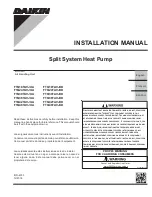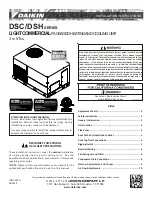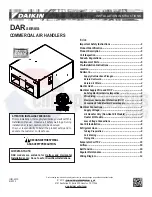
3
Electrical Supply Wire and MOP
HIGH VOLTAGE
To avoid the risk of fire or equipment
damage, use only copper conductors.
Disconnect ALL power before servicing or
installing this unit. Multiple power sources may
be present. The electrical power to this unit
MUST be in the OFF position and all power supplies
disconnected. Failure to do so may cause property
damage, personal injury or death.
The unit MUST have an uninterrupted, unbroken
electrical ground to minimize the possibility of
personal injury if an electrical fault should occur. The
electrical ground circuit may consist of an appropri-
ately sized electrical wire connecting the ground lug
in the unit and control box wire to the building’s
electrical service panel. Other methods of grounding
are permitted if performed in accordance with the
“National Electric Code” (NEC)/”American National
Standards Institute” (ANSI)/”National Fire Protection
Association” (NFPA) 70 and local/state codes. In
Canada, electrical grounding is to be in accordance
with the Canadian Electric Code CSA C22.1. Failure
to observe this warning can result in electrical shock
that can cause personal injury or death.
Inspection of the Building Electrical Service
This unit is designed for single-phase electrical supply. DO
NOT OPERATE ON A THREE-PHASE POWER SUPPLY.
Measure the power supply to the unit. The supply voltage
must
be in agreement with the unit nameplate power require-
ments and within the range shown in
Table 1
.
Nominal Input
Minimum Voltage
Maximum Voltage
208/230
187
253
Table 1
Wire Sizing
Wire size is important to the operation of your equipment. Use
the following check list when selecting the appropriate wire
size for your unit.
•
Wire size must carry the Minimum Circuit Ampacity
(MCA).
•
Wire size allows for no more than a 2% voltage drop
from the building breaker/fuse panel to the unit.
Refer to the latest edition of the National Electric Code or in
Canada the Canadian Electric Code when determining the cor-
rect wire size. The following table shows the current carrying
capabilities for copper conductors rated at 75
o
C with a 2%
voltage drop. Use
Table 2
to determine the voltage drop per
foot of various conductors.
10
15
20
25
30
35
40
45
14
75
50
37
NR
NR
NR
NR
NR
12
118
79
59
47
NR
NR
NR
NR
10
188
125
95
75
63
54
NR
NR
8
301
201
150
120
100
86
75
68
6
471
314
235
188
157
134
118
110
*Based on NEC 1996
Maximum Allowable Length in Feet
to Limit Voltage Drop to 2%*
Minimum Circuit Ampacity (MCA)
Wire Size
(AWG)
Table 2
Maximum Overcurrent Protection (MOP)
Every installation must include an NEC (USA) or CEC (Canada)
approved overcurrent protection device. Also, check with local
or state codes for any special regional requirements.
Protection can be in the form of fusing or HACR style circuit
breakers. The Series and Rating Plate can be used as a guide
for selecting the MAXIMUM overcurrent device.
NOTE:
Fuses or circuit breakers are to be sized larger than
the equipment MCA but not to exceed the MOP.
IMPORTANT NOTE:
Torch heat required to braze tubes of
various sizes is proportional to the size of the tube. Tubes of
smaller size require less heat to bring the tube to brazing
temperature before adding brazing alloy. Applying too much
heat to any tube can melt the tube. Service personnel must use
the appropriate heat level for the size of the tube being brazed.
NOTE:
The use of a heat shield when brazing is recommended
to avoid burning the serial plate or the finish on the unit. Heat
trap or wet rags should be used to protect heat sensitive
components such as service valves and TXV valves.
Electrical Connections – Supply Voltage
USE COPPER CONDUCTORS ONLY.
A knockout is provided on the air handler top panel or side to
allow for the entry of the supply voltage conductors. If the knock-
outs on the cabinet sides are used for electrical conduit, an
adapter ring must be used in order to meet UL1995 safety
requirements. An NEC or CEC approved strain relief is to be
used at this entry point. The wire is to be sized in accordance
with the “Electrical Wire and MOP” section of this manual.
Some areas require the supply wire to be enclosed in conduit.
Consult your local codes.

























